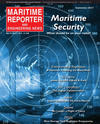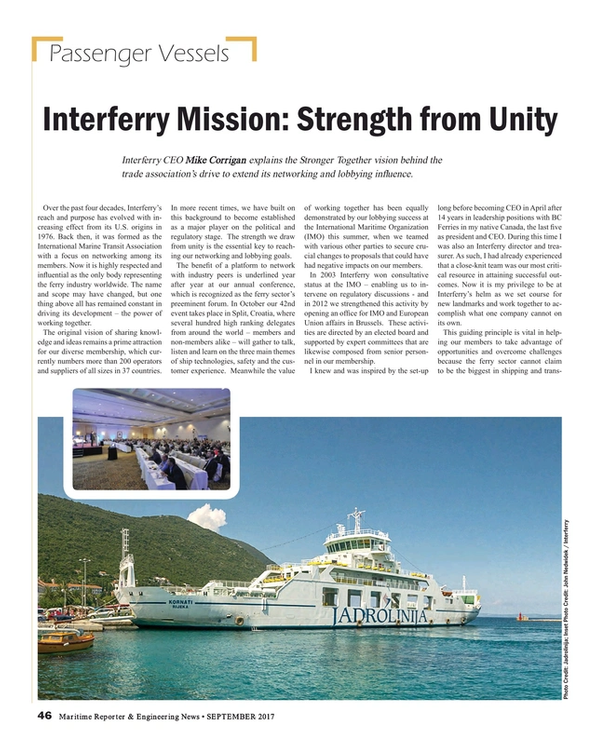
Interferry Mission: Strength from Unity
By Mike Corrigan
Interferry CEO Mike Corrigan explains the Stronger Together vision behind the trade association’s drive to extend its networking and lobbying influence.
Over the past four decades, Interferry’s reach and purpose has evolved with increasing effect from its U.S. origins in 1976. Back then, it was formed as the International Marine Transit Association with a focus on networking among its members. Now it is highly respected and influential as the only body representing the ferry industry worldwide. The name and scope may have changed, but one thing above all has remained constant in driving its development – the power of working together.
The original vision of sharing knowledge and ideas remains a prime attraction for our diverse membership, which currently numbers more than 200 operators and suppliers of all sizes in 37 countries. In more recent times, we have built on this background to become established as a major player on the political and regulatory stage. The strength we draw from unity is the essential key to reaching our networking and lobbying goals.
The benefit of a platform to network with industry peers is underlined year after year at our annual conference, which is recognized as the ferry sector’s preeminent forum. In October our 42nd event takes place in Split, Croatia, where several hundred high ranking delegates from around the world – members and non-members alike – will gather to talk, listen and learn on the three main themes of ship technologies, safety and the customer experience. Meanwhile the value of working together has been equally demonstrated by our lobbying success at the International Maritime Organization (IMO) this summer, when we teamed with various other parties to secure crucial changes to proposals that could have had negative impacts on our members.
In 2003 Interferry won consultative status at the IMO – enabling us to intervene on regulatory discussions - and in 2012 we strengthened this activity by opening an office for IMO and European Union affairs in Brussels. These activities are directed by an elected board and supported by expert committees that are likewise composed from senior personnel in our membership.
I knew and was inspired by the set-up long before becoming CEO in April after 14 years in leadership positions with BC Ferries in my native Canada, the last five as president and CEO. During this time I was also an Interferry director and treasurer. As such, I had already experienced that a close-knit team was our most critical resource in attaining successful outcomes. Now it is my privilege to be at Interferry’s helm as we set course for new landmarks and work together to accomplish what one company cannot on its own.
This guiding principle is vital in helping our members to take advantage of opportunities and overcome challenges because the ferry sector cannot claim to be the biggest in shipping and transport. However, we could make a case for being one of the most important – very often we provide lifeline services to far-flung communities. And we are far from small … globally we carry more than two billion passengers a year, almost on a par with airlines, and 32 million freight units. All the same, ferries are frequently in danger of being underrated and overlooked by politicians and regulators, so banding together helps us stress to them the full weight of our worth as a safe, eco-friendly and economically valuable asset to society.
To drive our networking and lobbying vision further forward, we are now rolling out an ambitious three-year strategic plan to advance the association’s profile, which in turn will ensure the strength and benefits of membership. Among the prime objectives, we aim to grow Interferry’s ‘voice of the industry’ role; to extend our safety and quality improvement campaign; to increase our part in developing international regulations; and to create more opportunities for knowledge exchange.
As mentioned earlier, we have already been instrumental in achieving significant changes to regulatory proposals that, after years of discussion, were again under the spotlight at the latest sessions of IMO’s safety and environmental protection committees. In league with other prominent stakeholders, we argued that on three major issues – The Energy Efficiency Design Index, The Ballast Water Management Convention and Damage Stability – the potential technical solutions might be acceptable for deep sea vessels, but posed immense problems regarding the very different design and operational criteria for ferries. In each case we won agreement for sector-specific amendments that will safeguard the regulatory objectives without threatening our sector’s commercial viability.
On the EEDI issue, Interferry was joined by several Flag States that echoed our concerns about the requirement for newbuild ships to be more energy efficient than the average of old designs. Our technical evidence demonstrated the difficulty of determining what is an average ferry – and resulted in the ferry requirement being reduced by 20 percent. An upper size deadweight tonnage threshold was also agreed in acknowledgement that the statistics used to define the original requirement included very few large ferries.
Concerns over the BWMC stemmed from our view that the threat posed by invasive species was not relevant to ferries operating in regional rather than inter-continental waters, which brought the requirement to fit expensive treatment plant into question.
In cooperation with the International Chamber of Shipping and various Flag States, we won agreement for the compliance timetable in applicable waters to be extended by several years. In addition, the IMO agreed a way forward for adoption of our alternative Same Risk Area concept – developed with Denmark and Singapore – for ships operating in common waters.
In similar vein, Interferry has long questioned damage stability proposals that, in effect, seek to produce the unsinkable ship by adding more steel. We would much rather see more research on avoiding collisions in the first place, but leaving that aside we were alarmed that the operational capability of ferries might be seriously impaired – for instance, if sub-division of their drive-through vehicle decks was required. We teamed up with Japan and other countries to ensure that the technical guidelines could be achieved, especially for smaller ferries. Our interventions secured a set of regulations that overthrew previously agreed levels of ‘unsinkability’ and which we believe to be reasonable for ferries carrying less than 1,000 passengers.
Sharing expertise and experience in such partnerships is, of course, also exemplified when ferry professionals come together on matters of common interest at our annual conference.
Our highly interactive program in Split features four keynote speakers among the presentations, as well as an extended lineup of panel sessions. The ship technology theme will pay particular attention to electrification and other energy alternatives; the safety agenda will highlight Interferry’s best practice guides and newly formed Safety Committee; and the customer experience sessions will cover a host of IT and other innovations designed to elevate passenger satisfaction.
Our keynote speakers are Markku Mylly, executive director of the European Maritime Safety Agency, with an update on the latest initiatives; John Wright, managing director of safety culture specialist WrightWay, who will explain why the safest companies are also the most successful; Brent Perry, head of Plan B Energy Storage, a world leader in alternative ferry fuels; and futurist David Rowan, U.K. editor of Wired, the U.S.-based future technology magazine, who will explore the ‘next big things’ that will propel the ferry industry into a new age. Topics in other sessions range from demographics, intermodal opportunities and fast ferries to digitalization, Big Data and cybersecurity, so I can safely predict there will be something to learn for each and every delegate!
Beyond the conference, Interferry is planning to provide additional networking platforms in the future. In particular, we want to establish regional meetings as a helping hand in attracting new members, especially from countries outside our core membership bases in the Americas and Europe.
In the meantime, if you’re involved with ferries and whether or not you are part of the Interferry family, I really hope you are able to come to Croatia and see for yourself where togetherness can take us. Our industry is set for an exciting new era if it rises to the challenge of inevitable hurdles and to the potential of new opportunities. I believe this can best be realised with the collective power that Interferry offers – so I look forward to you joining us on our Stronger Together mission.
Interferry at a Glance
What: 42nd Interferry Conference
When: October 7-11, 2017
Where: Split, Croatia
Twitter: @InterferryOrg
(As published in the September 2017 edition of Maritime Reporter & Engineering News)
Read Interferry Mission: Strength from Unity in Pdf, Flash or Html5 edition of September 2017 Maritime Reporter
Other stories from September 2017 issue
Content
- Marine Casualty Investigation page: 10
- The Art of Navigation page: 14
- The Nautical Safety Profile page: 14
- Ocean Guardian: Simplifying Environmental Compliance page: 16
- LNG: Maritime's 'Fuel of the Future' page: 20
- USCG Releases Draft Cyber Guide for Maritime Facilities page: 28
- Data Analytics in the Maritime Space page: 29
- Inside the USS Gerald R. Ford page: 30
- Aerial Drones Take Flight in Maritime page: 38
- FPSOs: New Storage Tank Explosion Frequencies page: 42
- Interferry Mission: Strength from Unity page: 46


